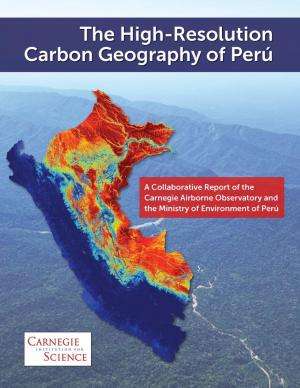Peru's carbon quantified: Economic and conservation boon

Today scientists unveiled the first high-resolution map of the carbon stocks stored on land throughout the entire country of Perú. The new and improved methodology used to make the map marks a sea change for future market-based carbon economies. The new carbon map also reveals Perú's extremely high ecological diversity and it provides the critical input to studies of deforestation and forest degradation for conservation, land use, and enforcement purposes. The technique includes the determination of uncertainty of carbon stores throughout the country, which is essential for decision makers. The mapping project is a joint effort among the Carnegie Airborne Observatory (CAO), led by Carnegie's Greg Asner, the Ministry of Environment of Perú, and Wake Forest University.
Historically two obstacles have slowed accurate carbon inventories at national scales. The first is the inadequate resolution of satellite mapping data and the second is the inaccuracy of on-the-ground surveys. These barriers must be overcome to support policies and markets that depend on timely knowledge of where carbon is stored on land. With its huge range of environments from cold Andean deserts to hot Amazonian rainforests, Perú is an ideal country for advancing high-tech carbon inventories.
Asner remarked: "The international community wants to use a combination of carbon sequestration and emissions reductions to combat climate change. Some 15% of global carbon emissions result from deforestation and forest degradation, which releases carbon dioxide to the atmosphere as trees are destroyed. Our cost-effective approach allows us to accurately map the carbon in this incredibly diverse country for the first time. It opens Perú's door to carbon sequestration agreements and is an enormous boon to conservation and monitoring efforts over vast areas for the long term."
The critical resolution for carbon monitoring is the hectare (2.5 acres). It is the world's most common unit of land tenure and policy enforcement, yet very few countries have advanced their carbon monitoring efforts at such high resolution. The team integrated airborne laser mapping technology using the Carnegie Airborne Observatory with field data, and coupled them with publicly available satellite imagery to scale carbon inventories up to the national level. The CAO sweeps laser light across the vegetation canopy to image it in 3-D, enabling the determination of the location and size of each tree at a resolution of 3.5 feet (1.1 meter). By combining the CAO laser information with satellite maps of forest cover, deforestation, and other environmental variables generated by the Peruvian Environment Ministry's Directorate of Land Management, a cost-effective means to monitor the country into the future has been established.
The new map reveals that the total aboveground carbon stock of the country is currently 6.9 billion metric tons. But the carbon stocks vary by region and land ownership. The average carbon density for Peruvian rainforests is 99 metric tons of carbon per hectare, with the maximum density of 168 metric tons of carbon per hectare. The largest stocks are in the northern Peruvian Amazon and along the Brazil-Perú border. Regions of deforestation, such as Puerto Maldonado where gold mining has ravaged the area, had low to no carbon storage. The team also assessed 174 protected areas, finding that for every hectare of forest put into protection, an average 95 metric tons of carbon are stored on land, with even more carbon sequestered below the soil surface.
Miles Silman, report coauthor from Wake Forest University, added: "The Carnegie map is a monumental effort—from field to remote sensing to computation—that honestly lays out the methods, predictions, and their reliability for each hectare in Perú. Now every person in private enterprise and decision makers in regional, local, and national government has an estimate of carbon content for every place in Perú. It should ignite the imaginations of ecologists and earth scientists, and provide a road map for decision makers. The report also adds another exclamation point to the value of protected areas. If you choose carbon as your currency, parks in Amazonian Perú are the banks, and the bigger the area, the closer it gets to being Fort Knox."
More information: Full Report link ftp://dge.stanford.edu/pub/asner/carbonreport/CarnegiePeruCarbonReport-English.pdf
Provided by Carnegie Institution for Science


















